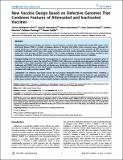Por favor, use este identificador para citar o enlazar a este item:
http://hdl.handle.net/10261/213525COMPARTIR / EXPORTAR:
 SHARE SHARE
 CORE
BASE CORE
BASE
|
|
| Visualizar otros formatos: MARC | Dublin Core | RDF | ORE | MODS | METS | DIDL | DATACITE | |

| Título: | New vaccine design based on defective genomes that combines features of attenuated and inactivated vaccines |
Autor: | Rodríguez-Calvo, Teresa; Ojosnegros Martos, Samuel; Sanz-Ramos Rojo, Marta; García-Arriaza, Juan CSIC ORCID ; Escarmís, Cristina ; Domingo, Esteban CSIC ORCID; Sevilla, Noemí CSIC ORCID | Fecha de publicación: | 29-abr-2010 | Editor: | Public Library of Science | Citación: | PLoS ONE 5 (2010) | Resumen: | Background: New vaccine designs are needed to control diseases associated with antigenically variable RNA viruses. Foot-and-mouth disease (FMD) is a highly contagious disease of livestock that inflicts severe economic losses. Although the current whole-virus chemically inactivated vaccine has proven effective, it has led to new outbreaks of FMD because of incomplete inactivation of the virus or the escape of infectious virus from vaccine production premises. We have previously shown that serial passages of FMD virus (FMDV) C-S8c1 at high multiplicity of infection in cell culture resulted in virus populations consisting of defective genomes that are infectious by complementation (termed C-S8p260). Principal Finding: Here we evaluate the immunogenicity of C-S8p260, first in a mouse model system to establish a proof of principle, and second, in swine, the natural host of FMDV C-S8c1. Mice were completely protected against a lethal challenge with FMDV C-S8c1, after vaccination with a single dose of C-S8p260. Pigs immunized with different C-S8p260 doses and challenged with FMDV C-S8c1 either did not develop any clinical signs or showed delayed and mild disease symptoms. C-S8p260 induced high titers of both FMDV-specific, neutralizing antibodies and activated FMDV-specific T cells in swine, that correlated with solid protection against FMDV. Conclusions: The defective virus-based vaccine did not produce detectable levels of transmissible FMDV. Therefore, a segmented, replication-competent form of a virus, such as FMDV C-S8p260, can provide the basis of a new generation of attenuated antiviral vaccines with two safety barriers. The design can be extended to any viral pathogen that encodes trans-acting gene products, allowing complementation between replication-competent, defective forms. © 2010 Rodríguez-Calvo et al. | Versión del editor: | http://dx.doi.org/10.1371/journal.pone.0010414 | URI: | http://hdl.handle.net/10261/213525 | DOI: | 10.1371/journal.pone.0010414 | Identificadores: | doi: 10.1371/journal.pone.0010414 issn: 1932-6203 |
| Aparece en las colecciones: | (CBM) Artículos (INIA) Artículos |
Ficheros en este ítem:
| Fichero | Descripción | Tamaño | Formato | |
|---|---|---|---|---|
| DomingoE_NewVaccineDesign.pdf | 423,4 kB | Adobe PDF |  Visualizar/Abrir |
CORE Recommender
PubMed Central
Citations
8
checked on 17-abr-2024
SCOPUSTM
Citations
10
checked on 18-abr-2024
WEB OF SCIENCETM
Citations
11
checked on 23-feb-2024
Page view(s)
123
checked on 18-abr-2024
Download(s)
95
checked on 18-abr-2024

